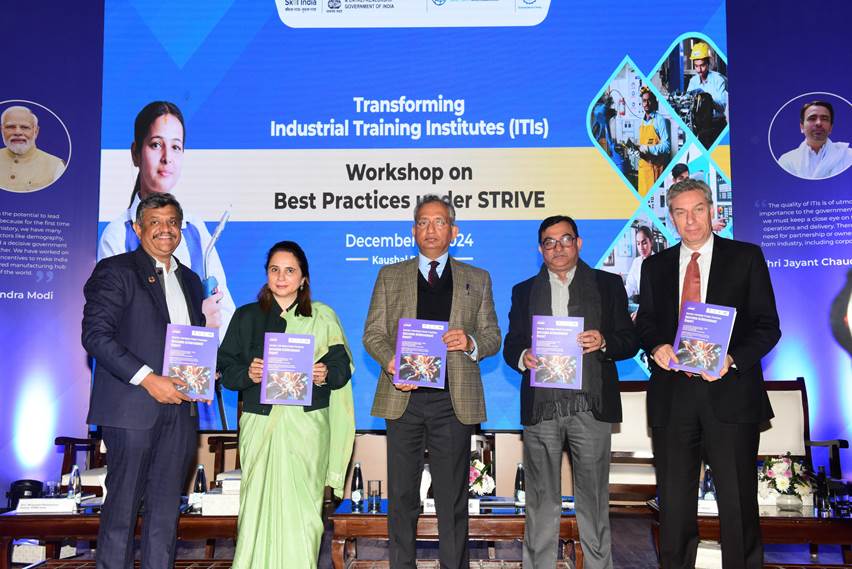Workplace safety and security are fundamental not only to safeguarding human life but also to achieving long-term, sustainable economic growth. A safe workplace fosters productivity, enhances employee morale, and ensures compliance with global labor standards, which are increasingly scrutinized in a connected global economy. For businesses of all sizes, ensuring workplace safety is a non-negotiable imperative. However, Micro, Small, and Medium Enterprises (MSMEs) face unique and often disproportionate challenges due to their limited resources, lack of access to training, and minimal regulatory oversight.
MSMEs form the backbone of global economies, contributing significantly to employment, innovation, and GDP. Yet, the very nature of these enterprises — characterized by resource constraints and high dependency on manual labor — makes their work environments particularly vulnerable to safety and security risks. Issues like outdated equipment, inadequate safety protocols, and insufficient awareness of global standards expose workers to hazards, while the enterprises themselves risk reputational and financial consequences.
Global Frameworks on Workplace Safety: ILO, UN, and the SDGs
Workplace safety is a cornerstone of global labor standards and economic development, championed by the International Labour Organization (ILO), United Nations (UN), and the Sustainable Development Goals (SDGs). Together, these frameworks create a robust, interlinked system to promote safe, secure, and inclusive working environments, particularly for vulnerable workers in high-risk industries such as manufacturing, construction, and agriculture.
The ILO’s Occupational Safety and Health Convention, 1981 (No. 155) and the Safety and Health in Construction Convention, 1988 (No. 167) form the foundation of international occupational safety and health (OSH) policies. These conventions advocate for comprehensive strategies, including:
Hazard Identification: Assessing potential risks to prevent accidents and injuries.
Workplace Inspections: Ensuring compliance with safety standards through routine monitoring.
Worker Training: Equipping employees with the skills and knowledge to maintain a safe work environment.
These conventions stress that safety is not merely a compliance measure but a core component of organizational sustainability, with a particular emphasis on MSMEs, where safety protocols are often underdeveloped.
Complementing the ILO’s efforts, the UN’s Resolution on Universal Social Protection (A/RES/72/141) underscores the critical need for comprehensive safety measures, especially for workers in precarious and informal employment. The resolution calls for universal access to safe working conditions as a means of ensuring human dignity and reducing inequalities in the workplace.
Workplace safety is also deeply embedded in the Sustainable Development Goals (SDGs), which provide a global framework for achieving inclusive and sustainable development:
SDG 8: Decent Work and Economic Growth: Calls for safe and secure working conditions for all, particularly in high-risk sectors.
SDG 3: Good Health and Well-being: Focuses on minimizing workplace-related illnesses, injuries, and fatalities.
SDG 9: Industry, Innovation, and Infrastructure: Encourages resilient, safe, and sustainable industrialization.
For MSMEs, these SDGs offer a clear pathway to integrate workplace safety into their operational strategies, ensuring both compliance and competitiveness in the global economy. Beyond regulatory mandates, adherence to these principles helps foster a culture of safety, reduce economic losses from workplace incidents, and boost worker morale and productivity.
Together, the ILO conventions, UN resolutions, and SDGs form a cohesive and powerful blueprint for transforming workplace safety standards worldwide. Their implementation, particularly in resource-constrained MSMEs, is essential not only for safeguarding lives but also for driving sustainable economic growth and achieving equitable development across industries and regions.
Challenges for MSMEs in Ensuring Workplace Safety
Micro, Small, and Medium Enterprises (MSMEs) are the lifeblood of many economies, contributing significantly to employment and GDP. However, their size and resource constraints often leave them vulnerable to workplace safety challenges. These vulnerabilities not only jeopardize worker well-being but also hinder long-term sustainability and growth. Below are some of the critical challenges MSMEs face in ensuring workplace safety:
Lack of Awareness About Safety Regulations
Many MSME owners and managers lack adequate knowledge about occupational safety and health (OSH) regulations and international best practices. In some cases, they are unaware of the importance of workplace safety beyond regulatory compliance. This knowledge gap often leads to inadequate implementation of even the most basic safety measures, such as hazard identification or worker training.
Insufficient Financial Resources
MSMEs often operate on tight budgets, with limited access to capital. As a result, safety investments—such as purchasing personal protective equipment (PPE), upgrading machinery, or hiring safety officers—are often deprioritized. The high upfront costs of these measures, coupled with the perception that they do not yield immediate financial returns, discourage many MSMEs from allocating resources to safety initiatives.
Minimal Enforcement of Workplace Safety Standards
In many countries, workplace safety regulations are poorly enforced, particularly in MSMEs. Resource constraints within government agencies mean inspections and monitoring often focus on larger enterprises. Consequently, MSMEs frequently operate without regular oversight, allowing unsafe practices to persist unchecked. This lack of enforcement exacerbates risks for workers and increases the likelihood of accidents.
Overdependence on Manual Labor
MSMEs often rely heavily on manual labor rather than automated systems. This dependence increases the likelihood of human error and exposes workers to greater physical risks, particularly in hazardous industries like manufacturing, construction, and mining.
Outdated Equipment and Practices
Many MSMEs use older machinery and outdated operational practices due to financial constraints or limited access to technology. Such equipment often lacks modern safety features, increasing the risk of mechanical failures, injuries, and accidents.
Informal Workforce and High Turnover Rates
A significant portion of MSME workers are part of the informal sector, lacking proper contracts or access to worker protections. High turnover rates among employees mean that many workers do not receive adequate safety training, perpetuating unsafe practices in the workplace.
Limited Access to Training and Expertise
MSMEs rarely have access to specialized training programs or safety consultants. Without expert guidance, they struggle to implement comprehensive safety management systems or conduct effective risk assessments.
Cultural Barriers and Resistance to Change
In some MSMEs, there is a cultural resistance to adopting new safety measures, particularly if these measures are perceived as costly or disruptive to productivity. This resistance often stems from a lack of understanding about the long-term benefits of workplace safety, including reduced downtime and enhanced employee morale.
Supply Chain Pressures
Many MSMEs operate within supply chains dominated by larger corporations, which impose stringent delivery schedules and cost constraints. These pressures often force MSMEs to prioritize production over safety, leading to shortcuts in implementing and maintaining safety protocols.
Disproportionately higher accident and injury rates
These challenges collectively result in disproportionately higher accident and injury rates in the MSME sector. Workers in these enterprises are often exposed to hazardous conditions, including unsafe machinery, inadequate protective equipment, and poorly maintained workspaces. Such conditions not only harm workers but also disrupt business operations, leading to financial losses, reputational damage, and potential legal liabilities for MSME owners.
Addressing these challenges requires a collaborative effort involving policymakers, industry bodies, and MSMEs themselves. By focusing on affordable safety solutions, capacity-building initiatives, and stricter enforcement of regulations, MSMEs can overcome these obstacles and create safer, more sustainable workplaces.
Case Studies of Workplace Accidents
United States
Deepwater Horizon Disaster (2010):
While primarily involving a large enterprise, the disaster shed light on the importance of stringent safety practices across all industries. Smaller firms in the oil supply chain suffered due to inadequate safety compliance, highlighting the ripple effects of unsafe practices.
Meatpacking Industry:
Reports from the Occupational Safety and Health Administration (OSHA) reveal that many MSMEs in meatpacking plants witness injuries due to improper use of machinery and insufficient safety protocols.
European Union
Germany’s Metalworking Industry (2019):
A fire at an MSME metalworking facility in Bavaria resulted in multiple fatalities and injuries. Investigations revealed poor storage of flammable materials and inadequate fire suppression systems.
France’s Small Construction Firms (2022):
A collapse at a construction site in Marseille injured several workers, revealing insufficient adherence to scaffolding safety standards and lack of proper inspections.
Bangladesh Garment Industry Tragedy (2013):
The Rana Plaza collapse serves as a global example of unsafe workplaces in MSMEs. Over 1,100 workers died due to structural failures, lack of building inspections, and overcrowding.
India’s Firecracker Industry:
An explosion in Tamil Nadu (2021) claimed multiple lives, emphasizing systemic non-compliance with safety norms, especially in small manufacturing units.
Enhancing Safety & ensuring better workspaces
Policy interventions tailored to MSMEs are crucial, including the implementation of specific safety regulations. The adoption of affordable technologies, such as IoT sensors, can provide real-time hazard monitoring, significantly enhancing workplace safety. Regular training programs, conducted in collaboration with organizations like the International Labour Organization (ILO), empower workers with essential safety knowledge and skills. Actively involving workers in safety committees fosters a culture of compliance and proactive risk identification, ensuring a safer work environment.
Safety policies aligned with ILO standards
To improve safety standards, SMEs should develop safety policies aligned with ILO standards, creating comprehensive safety frameworks. Regular workshops can help educate employees on safety protocols, while equipping worksites with first aid kits, fire extinguishers, and evacuation plans ensures emergency preparedness. Routine inspections to identify and address potential hazards are essential for maintaining a secure workplace. These measures collectively contribute to a robust safety culture within MSMEs.
Ensuring workplace safety is a critical priority for SMEs, not just as a regulatory mandate but as a moral imperative. By integrating principles from ILO conventions, UN resolutions, and SDGs, MSMEs can build safer environments for their workers. Learning from past accidents and adopting global best practices will ensure that SMEs thrive while safeguarding their workforce.
References
- International Labour Organization. (1981). Occupational Safety and Health Convention (No. 155).
- United Nations. (2018). Resolution on Universal Social Protection (A/RES/72/141).
- United Nations. (2015). Sustainable Development Goals (SDGs).
- Occupational Safety and Health Administration (OSHA). Workplace Accident Reports (2022).
- Rana Plaza Coordination Committee. Rana Plaza Final Report.
- European Agency for Safety and Health at Work. (2022). Workplace Safety in SMEs across Europe.
- Ministry of Labour and Employment, India. (2021). Workplace Accidents in MSMEs.
Author Profile

Latest entries
 Reports30 October 2025WALK TO WORK: A CONCEPT BROUGHT TO LIFE
Reports30 October 2025WALK TO WORK: A CONCEPT BROUGHT TO LIFE Data18 October 2025Global Study on Startups and Family Firms: Cross-Learning for Growth and Resilience
Data18 October 2025Global Study on Startups and Family Firms: Cross-Learning for Growth and Resilience AI17 October 2025Professor Nelson Granados Joins Prow™ as Chief Intelligence Officer, Strengthening AI and Academic Leadership
AI17 October 2025Professor Nelson Granados Joins Prow™ as Chief Intelligence Officer, Strengthening AI and Academic LeadershipUncategorised11 February 2025Wearable Technology Market Poised for Growth: Opportunities for SMEs in the Expanding Ecosystem














